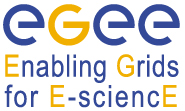Speakers
Report on the impact of the activity, tool or service. This should include a description of how grid technology enabled or enhanced the result, or how you have enabled or enhanced the infrastructure for other users.
The Grid advanced processing and storage capabilities on-demand made possible to increase the resolution of the output risk maps from 1 km square to 100 m, which was previously impossible to obtain both for computing power limits and for data storage problems. Moreover, in order to reduce time delays, a message notification strategy from WN to Web services has been implemented. This further improves intrinsic Grid's parallelism and permits to obtain a time of response almost independent from the resolution. The infrastructure was enhanced building a layer of geospatial data sharing services which could be used by other applications. These services provide a standard Web Service interface (OGC Web Coverage Service and OGC Web Processing Service) to interoperate with existing Spatial Data Infrastructures, but make use of the underlying grid capabilities for computing and storage.
Abstracts for online demonstrations must provide a summary of the demo content. Places for demos are limited and this summary will be used as part of the selection procedure. Please include the visual impact of the demo and highlight any specific requirements (e.g. network connection). In general, a successful demo is expected to have some supporting material (poster) and be capable of running on a single screen or projector.
The demo shows an example of using G-RISICO: from a Graphical User Interface the Civil Protection operator selects the desired area and resolution and submits the request for fire risk maps. Other tabs in the GUI shows what is happening behind the scenes (Web Services interaction, input preparation, job submission and output collection). Finally the results are shown as maps. For the live demo a network connection (wired or wireless) with a reasonable bandwidth is required. As supporting material a poster and a movie capture of the demo with audio comment are also provided. It lasts about five minutes and can be shown in loop using a PC screen or a projector.
Describe the added value of the grid for your activity, or the value your tool or service adds for other grid users. This should include the scale of the activity and of the potential user community, and the relevance for other scientific or business applications.
Large, infrequent wildfires cause dramatic ecological and economic impacts. These events often need the transnational cooperation. Only a common tool able to define the wildfire risk at global scale allows Civil Protections to take decision about aerial means relocation. In this context G-RISICO is the demonstration of how Grid technologies can be useful for the construction of a transnational infrastructure for Civil Protection. A newly developed geospatial services layer allows to make the applications built on top of it interoperable with other existing or planned spatial data infrastructures (e.g. in INSPIRE, GEOSS, GMES initiatives). Such layer could be used and extended by other applications needing to share geospatial data in a standard way. The resulting G-RISICO application is currently usable for Wild Fire Risk Assessment outside the original coverage (Italy) provided that input data are available.
Describe the activity, tool or service using or enhancing the EGEE infrastructure or results. A high-level description is needed here (Neither a detailed specialist report nor a list of references is required).
In the context of the FP6 Project CYCLOPS (Cyber-infrastructure for CiviL protection Operative ProcedureS) the application used by the Italian Department of Civil Protection for Wild Fires Risk Assessment, named RISICO, has been ported on top of the EGEE Grid Infrastructure. A layer of services for enhancing the Grid middleware (with notification functionalities) and for geospatial data sharing (implementing standard interfaces based on the Open Geospatial specifications) has been developed.
